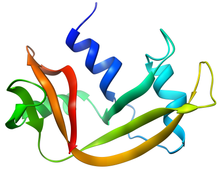| Pancreatic ribonuclease | |||||||||
|---|---|---|---|---|---|---|---|---|---|
 Structure of RNase A Structure of RNase A | |||||||||
| Identifiers | |||||||||
| EC no. | 4.6.1.18 | ||||||||
| CAS no. | 9001-99-4 | ||||||||
| Databases | |||||||||
| IntEnz | IntEnz view | ||||||||
| BRENDA | BRENDA entry | ||||||||
| ExPASy | NiceZyme view | ||||||||
| KEGG | KEGG entry | ||||||||
| MetaCyc | metabolic pathway | ||||||||
| PRIAM | profile | ||||||||
| PDB structures | RCSB PDB PDBe PDBsum | ||||||||
| Gene Ontology | AmiGO / QuickGO | ||||||||
| |||||||||
| Pancreatic ribonuclease | |||||||||||
|---|---|---|---|---|---|---|---|---|---|---|---|
| Identifiers | |||||||||||
| Symbol | RNaseA | ||||||||||
| Pfam | PF00074 | ||||||||||
| InterPro | IPR001427 | ||||||||||
| SMART | SM00092 | ||||||||||
| PROSITE | PDOC00118 | ||||||||||
| |||||||||||
Pancreatic ribonuclease family (EC 4.6.1.18, RNase, RNase I, RNase A, pancreatic RNase, ribonuclease I, endoribonuclease I, ribonucleic phosphatase, alkaline ribonuclease, ribonuclease, gene S glycoproteins, Ceratitis capitata alkaline ribonuclease, SLSG glycoproteins, gene S locus-specific glycoproteins, S-genotype-assocd. glycoproteins, ribonucleate 3'-pyrimidino-oligonucleotidohydrolase) is a superfamily of pyrimidine-specific endonucleases found in high quantity in the pancreas of certain mammals and of some reptiles.
Specifically, the enzymes are involved in endonucleolytic cleavage of 3'-phosphomononucleotides and 3'-phosphooligonucleotides ending in C-P or U-P with 2',3'-cyclic phosphate intermediates. Ribonuclease can unwind the RNA helix by complexing with single-stranded RNA; the complex arises by an extended multi-site cation-anion interaction between lysine and arginine residues of the enzyme and phosphate groups of the nucleotides.
Notable family members
Bovine pancreatic ribonuclease is the best-studied member of the family and has served as a model system in work related to protein folding, disulfide bond formation, protein crystallography and spectroscopy, and protein dynamics. The human genome contains 8 genes that share the structure and function with bovine pancreatic ribonuclease, with 5 additional pseudo-genes. The structure and dynamics of these enzymes are related to their diverse biological functions.
Other proteins belonging to the pancreatic ribonuclease superfamily include: bovine seminal vesicle and brain ribonucleases; kidney non-secretory ribonucleases; liver-type ribonucleases; angiogenin, which induces vascularisation of normal and malignant tissues; eosinophil cationic protein, a cytotoxin and helminthotoxin with ribonuclease activity; and frog liver ribonuclease and frog sialic acid-binding lectin. The sequence of pancreatic ribonucleases contains four conserved disulfide bonds and three amino acid residues involved in the catalytic activity.
Human genes
Human genes encoding proteins containing this domain include:
Cytotoxicity
Some members of the pancreatic ribonuclease family have cytotoxic effects. Mammalian cells are protected from these effects due to their extremely high affinity for ribonuclease inhibitor (RI), which protects cellular RNA from degradation by pancreatic ribonucleases. Pancreatic ribonucleases that are not inhibited by RI are approximately as toxic as alpha-sarcin, diphtheria toxin, or ricin.
Two pancreatic ribonucleases isolated from the oocytes of the Northern leopard frog - amphinase and ranpirnase - are not inhibited by RI and show differential cytotoxicity against tumor cells. Ranpirnase was studied in a Phase III clinical trial as a treatment candidate for mesothelioma, but the trial did not demonstrate statistical significance against primary endpoints.
References
- Beintema JJ, van der Laan JM (1986). "Comparison of the structure of turtle pancreatic ribonuclease with those of mammalian ribonucleases". FEBS Lett. 194 (2): 338–343. doi:10.1016/0014-5793(86)80113-2. PMID 3940901. S2CID 21907373.
- Marshall GR, Feng JA, Kuster DJ (2008). "Back to the future: ribonuclease A". Biopolymers. 90 (3): 259–77. doi:10.1002/bip.20845. PMID 17868092. S2CID 2905312.
- Narayanan C, Bernard DN, Bafna K, Gagné D, Chennubhotla CS, Doucet N, Agarwal PK (Mar 2018). "Conservation of Dynamics Associated with Biological Function in an Enzyme Superfamily". Structure. 26 (3): 426–436. doi:10.1016/j.str.2018.01.015. PMC 5842143. PMID 29478822.
- Rosenberg HF, Tenen DG, Ackerman SJ (1989). "Molecular cloning of the human eosinophil-derived neurotoxin: a member of the ribonuclease gene family". Proc. Natl. Acad. Sci. U.S.A. 86 (12): 4460–4464. Bibcode:1989PNAS...86.4460R. doi:10.1073/pnas.86.12.4460. PMC 287289. PMID 2734298.
- Hofsteenge J, Matthies R, Stone SR (1989). "Primary structure of a ribonuclease from porcine liver, a new member of the ribonuclease superfamily". Biochemistry. 28 (25): 9806–9813. doi:10.1021/bi00451a040. PMID 2611266.
- Rosenberg HF, Ackerman SJ, Tenen DG (1989). "Human eosinophil cationic protein. Molecular cloning of a cytotoxin and helminthotoxin with ribonuclease activity". J. Exp. Med. 170 (1): 163–176. doi:10.1084/jem.170.1.163. PMC 2189377. PMID 2473157.
- Raines RT (1998). "Ribonuclease A". Chem. Rev. 98 (3): 1045–1066. doi:10.1021/cr960427h. PMID 11848924.
- Gaur, D; Swaminathan, S; Batra, JK (6 July 2001). "Interaction of human pancreatic ribonuclease with human ribonuclease inhibitor. Generation of inhibitor-resistant cytotoxic variants". The Journal of Biological Chemistry. 276 (27): 24978–84. doi:10.1074/jbc.m102440200. PMID 11342552.
- Saxena, SK; Rybak, SM; Winkler, G; Meade, HM; McGray, P; Youle, RJ; Ackerman, EJ (5 November 1991). "Comparison of RNases and toxins upon injection into Xenopus oocytes". The Journal of Biological Chemistry. 266 (31): 21208–14. doi:10.1016/S0021-9258(18)54842-0. PMID 1939163.
- Lee JE, Raines RT (2008). "Ribonucleases as novel chemotherapeutics : the ranpirnase example". BioDrugs. 22 (1): 53–58. doi:10.2165/00063030-200822010-00006. PMC 2802594. PMID 18215091.
- "Alfacell Annual Report 2009" (PDF). Retrieved 2 February 2015.
| Enzymes | |
|---|---|
| Activity | |
| Regulation | |
| Classification | |
| Kinetics | |
| Types |
|